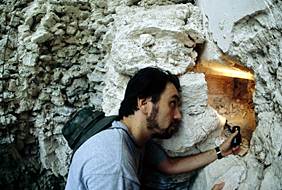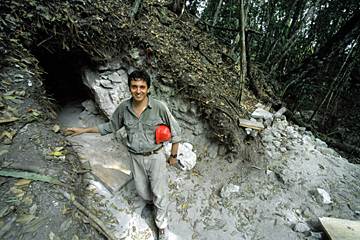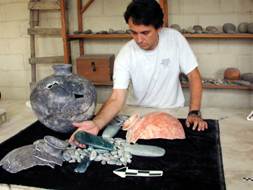
| Photo by Kenneth Garrett/National Geographic. |
By Joel Skidmore
|
May 5, 2004. The National Geographic Society announced today that excavations at the 2000-year-old Maya site of Cival in Guatemala (map) have revealed it to be one of the earliest and largest cities of the Preclassic era. An archaeological project under the direction of Francisco Estrada-Belli of Vanderbilt University (pictured above) has uncovered two monumental carved masks and elaborate jade ritual objects in recent excavations of the city's central plaza. These finds have further contributed to pushing back what are considered to be the hallmarks of Classic Maya civilization well into the Preclassic era.
Tradition dates the Preclassic Period from 2000 B.C. to A.D. 250, and the Classic from A.D. 250 to 900. Estrada-Belli dates Cival to about 150 B.C. "'Preclassic' is a misnomer," according to the archaeologist. "Preclassic Maya societies already had many features that have been attributed to the Classic period — kings, complex iconography, elaborate palaces and burials." Estrada-Belli estimates that Cival may have housed 10,000 people at its peak, making it one of the largest cities of the Preclassic Maya. In this regard it might have surpassed Holmul, the nearby site that supplanted it in regional dominance in the Classic. An expert in the archaeological use of technology, Estrada-Belli used satellite imaging to spot possible archaeological sites, followed up on the ground using GPS, and then used a computer to generate sophisticated maps of the area. Estrada-Belli and his team have determined that Cival's ceremonial center extended for half a mile, twice the extent estimated by Cival's discoverer, explorer Ian Graham of the Corpus of Maya Hieroglyphics Project. Graham told the New York Times that when he mapped the site twenty years ago the jungle concealed all but the outlines of some of the buildings and pyramids. The first of the two 5x3 meter stucco facade masks was discovered during the inspection of a looter's trench when Estrada-Belli reached into a crack in the wall and felt a section of stucco carving. In a presentation at the Maya Meetings at Texas last March, the archaeologist showed photographs and described a "were-jaguar" mouth and other Olmecoid features, as well as a U-shaped motif that appears in the recently discovered Preclassic murals of San Bartolo, Guatemala. Just this April a second mask was discovered on the other side of a set of stairs. Estrada-Belli believes that there were originally two pairs of masks flanking a pyramid stairway. The new mask has what appears to be corn husks adorning the eyes, suggesting an association with the Maya maize god who appears as a central figure in the San Bartolo iconography. Another significant find in Cival was an offering cache in the main plaza. Behind a recess holding a red bowl, two spondylus shells and a jade tube, was a depression in the shape of a cross containing five smashed jars, one of which was placed in the center of the cross. Under this jar, according to the National Geographic press release, "were 120 pieces of jade, most of them round, polished green and blue jade pebbles." Five jade axes were placed nearby with their blades pointing upwards. The photo below shows some of these offerings. |
According to the National Geographic press release,
Excavation of the tunnel that led to the ancient mask was led by Guatemalan archaeologist Angel Castillo. Vanderbilt University graduate students Molly Morgan and Jeremy Bauer excavated the jade offering. An earlier discovery by the team working at Cival was what may be the earliest carved stela in the Maya lowlands, dating to 300 B.C. Online see Preclassic Maya monuments and temples at Cival, Petén, Guatemala by Francisco Estrada-Belli, Nikolai Grube, Marc Wolf, Kristen Gardella and Claudio Lozano Guerra-Librero. The authors discuss Cival Stela 2:
Cival is listed in The Corpus of Maya Hieroglyphic Inscriptions "Sources of Sculpture and their Codes" and designated CVL (Graham and Mathews 1999). In an article in Mexicon, Estrada-Belli (2002) describes Cival as a large ceremonial center that extends along the borders of a cival, or lagoon, from which it takes its name. The largest structure, a triadic group of about 27 meters, has Late Preclassic features. Estrada-Belli suggested that given this impressive construction, the Preclassic relationship with neighboring Holmul, which emerged as a center of power during the Classic, is worthy of further investigation. Estrada-Belli also directs the archaeological project at Holmul. Online at FAMSI, see Archaeological Investigations at Holmul, Petén, Guatemala (Preliminary Results of the Third Season, 2002). In the photograph below, he peers through a window at the remains of a painted wall. Teotihuacan-style murals have been found by Estrada-Belli and his team at Holmul. |

Photo: Kenneth Garrett/National Geographic.
|
The Cival project, the San Bartolo murals and Richard Hansen's work at the Preclassic site of El Mirador are featured in a National Geographic documentary airing on PBS next week. See press release.
Although the finds at Cival, San Bartolo and El Mirador have changed our understanding of the term Preclassic, it is worth considering that the traditional distinction of a shift around the year A.D. 250 is still meaningful. Dynastic counts such as those seen at Tikal and other Classic Maya sites, as well as other indications of a focus on dynastic rule, are not apparent in the Preclassic. As Simon Martin (2003:4) observes,
|

